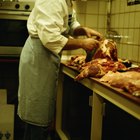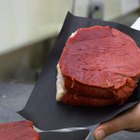
The front part of a cow, also called the forequarter, produces a range of cuts of meat that are used in many different beef dishes. The cuts of meat from the front of the cow are typically less expensive than the ones toward the rear, but with proper cooking methods they are just as tender and tasty.
Cuts From the Front
The front of the cow includes the plate cuts, chuck and shoulder cuts, and fore shank and brisket cuts. The plate area is located on the bottom of the cow, just under the rib section. You can get one type of steak from the plate section, which is the skirt steak. From the chuck and shoulder area of the cow, you can get chuck steak, blade steak, arm steak, shoulder steak, seven-bone steak, mock tender steak and chuck eye. The fore shank and brisket area includes the front legs and area around them. The brisket, right behind the fore shank, is used for several different dishes.
Using Forequarter Cuts
The variety of cuts from the front of the cow are good for different types of steak dinners, stews, and hamburgers. Fajitas are often made using the tender skirt steak, while ground chuck is used for hamburgers and meat loaf. Blade steak is one of the more tender steaks you can eat, once you remove a band of connective tissue down the center. Beef brisket is often smoked or barbecued, and beef brisket pot roast works well in a slow cooker. Most steaks from the chuck region are tough to begin with, but work well when tenderized and braised -- or slow-roasted until they become tender -- or cut into cubes and added as part of a stew.
Difference Front to Back
Perhaps the main difference in the cuts from the front with the cuts from the back of the cow is the tenderness of the meat. Many of the muscles in the hindquarter of a cow are seldom used, so they are more tender than muscles used frequently. The rib, loin and sirloin sections are in the back and they have the more tender -- and consequently expensive -- cuts of meat. Forequarter cuts are tougher and many require moist methods of cooking, but they do cost less and often end up more flavorful than the tender cuts.
Beef Safety
Cooking meat to safe temperatures is always worth mentioning, but luckily the low and slow cooking requirements of most forequarter cuts make it a nonissue. Steaks and roasts should be cooked to an internal temperature of 145 degrees Fahrenheit, according to the Foodsafety.gov website. It also recommends letting the cooked meat rest for three minutes to help destroy dangerous germs. Ground beef should be cooked to 160 degrees F with no rest time afterward.
Related Articles

What Cuts of Meat Are Used for Ground ...

Cuts of Meat From a Front Quarter of ...

How to Cook Kobe Steaks

How to Cook Boneless Country Spare Ribs

Different Cuts of Steak
Difference Between Ribeye Steak & ...
Is Ball Tip Steak Good for Grilling?

What Cuts of Meat Can I Get From Deer ...

How to Get Skirt Steak Tender
Cuts of Meat From a Side of Beef

How to Convection Roast a Brisket

How to Slice Round Steak for Jerky

How to Cook a Tender Steak Using a ...

How to Cook Tender Rolled Flank Steaks ...

Meat Parts of a Lamb

Filet vs. Strip vs. Sirloin

What Is the Difference in Top Sirloin & ...

How to Cook London Broil

How to Cook Angus Beef Steak

Tri Tip Cooking Methods
References
Writer Bio
Joshua McCarron has been writing both online and offline since 1995. He has been employed as a copywriter since 2005 and in that position has written numerous blogs, online articles, websites, sales letters and news releases. McCarron graduated from York University in Toronto with a bachelor's degree in English.
Photo Credits
BananaStock/BananaStock/Getty Images